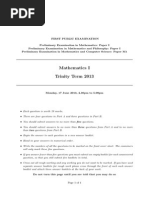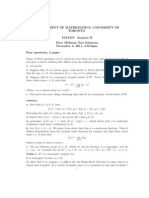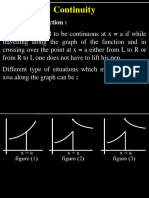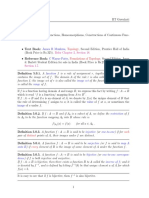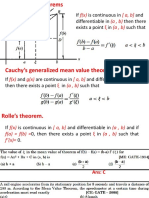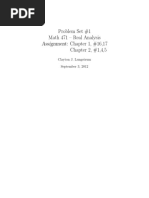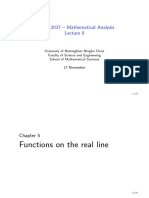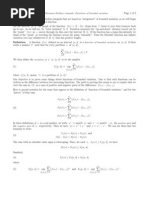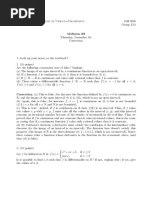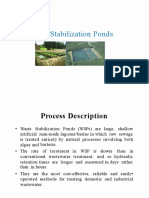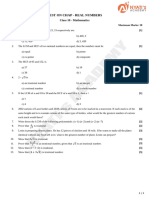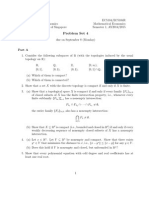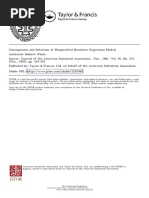Real Analysis: Chapter 6. Differentiation and Integration 6.1. Continuity and Monotone Functions-Proofs of Theorems
Real Analysis: Chapter 6. Differentiation and Integration 6.1. Continuity and Monotone Functions-Proofs of Theorems
Uploaded by
bini1221Copyright:
Available Formats
Real Analysis: Chapter 6. Differentiation and Integration 6.1. Continuity and Monotone Functions-Proofs of Theorems
Real Analysis: Chapter 6. Differentiation and Integration 6.1. Continuity and Monotone Functions-Proofs of Theorems
Uploaded by
bini1221Original Title
Copyright
Available Formats
Share this document
Did you find this document useful?
Is this content inappropriate?
Copyright:
Available Formats
Real Analysis: Chapter 6. Differentiation and Integration 6.1. Continuity and Monotone Functions-Proofs of Theorems
Real Analysis: Chapter 6. Differentiation and Integration 6.1. Continuity and Monotone Functions-Proofs of Theorems
Uploaded by
bini1221Copyright:
Available Formats
Real Analysis
Chapter 6. Differentiation and Integration
6.1. Continuity and Monotone Functions—Proofs of Theorems
December 25, 2015
() Real Analysis December 25, 2015 1/6
Table of contents
1 Theorem 6.1
2 Proposition 6.2
() Real Analysis December 25, 2015 2/6
Theorem 6.1
Theorem 6.1
Theorem 6.1. The f be a monotone function on the open interval (a, b).
Then f is continuous except possibly at a countable number of points in
(a, b).
Proof. WLOG, say f is monotone increasing.
() Real Analysis December 25, 2015 3/6
Theorem 6.1
Theorem 6.1
Theorem 6.1. The f be a monotone function on the open interval (a, b).
Then f is continuous except possibly at a countable number of points in
(a, b).
Proof. WLOG, say f is monotone increasing. Furthermore, assume (a, b)
is bounded (that is, a and b are finite) and f is increasing on the closed
interval [a, b]. Otherwise, express (a, b) as the union of an ascending
sequence of open, bounded intervals, the closures of which are contained
in (a, b) (which can be done if a and b are finite with a ±1/n approach, or
with a ±n approach if a and/or b is infinite). Then take the unions of the
discontinuities in each of this countable collection of intervals.
() Real Analysis December 25, 2015 3/6
Theorem 6.1
Theorem 6.1
Theorem 6.1. The f be a monotone function on the open interval (a, b).
Then f is continuous except possibly at a countable number of points in
(a, b).
Proof. WLOG, say f is monotone increasing. Furthermore, assume (a, b)
is bounded (that is, a and b are finite) and f is increasing on the closed
interval [a, b]. Otherwise, express (a, b) as the union of an ascending
sequence of open, bounded intervals, the closures of which are contained
in (a, b) (which can be done if a and b are finite with a ±1/n approach, or
with a ±n approach if a and/or b is infinite). Then take the unions of the
discontinuities in each of this countable collection of intervals.
For each x0 ∈ (a, b), f has a finite limit from the left and from the right at
a0 . Define
f (x0− ) = lim f (x) = sup{f (x) | a < x < x0 },
x→x0−
f (x0+ ) = lim+ f (x) = inf{f (x) | x0 < x < b}.
x→x0
() Real Analysis December 25, 2015 3/6
Theorem 6.1
Theorem 6.1
Theorem 6.1. The f be a monotone function on the open interval (a, b).
Then f is continuous except possibly at a countable number of points in
(a, b).
Proof. WLOG, say f is monotone increasing. Furthermore, assume (a, b)
is bounded (that is, a and b are finite) and f is increasing on the closed
interval [a, b]. Otherwise, express (a, b) as the union of an ascending
sequence of open, bounded intervals, the closures of which are contained
in (a, b) (which can be done if a and b are finite with a ±1/n approach, or
with a ±n approach if a and/or b is infinite). Then take the unions of the
discontinuities in each of this countable collection of intervals.
For each x0 ∈ (a, b), f has a finite limit from the left and from the right at
a0 . Define
f (x0− ) = lim f (x) = sup{f (x) | a < x < x0 },
x→x0−
f (x0+ ) = lim+ f (x) = inf{f (x) | x0 < x < b}.
x→x0
() Real Analysis December 25, 2015 3/6
Theorem 6.1
Theorem 6.1 (continued)
Theorem 6.1. The f be a monotone function on the open interval (a, b).
Then f is continuous except possibly at a countable number of points in
(a, b).
Proof (continued). Since f is increasing, then f (x0− ) ≤ f (x0+ ). So f has
a discontinuity at x0 if and only if f (x0− ) < f (x0+ ), in which case there is a
jump discontinuity at x0 . Define the “jump” interval
J(x0 ) = {y | f (x0− ) < y < f (x0+ )}. Each jump interval is contained in the
bounded interval [f (a), f (b)] and the collection of jump intervals is
(pairwise) disjoint.
() Real Analysis December 25, 2015 4/6
Theorem 6.1
Theorem 6.1 (continued)
Theorem 6.1. The f be a monotone function on the open interval (a, b).
Then f is continuous except possibly at a countable number of points in
(a, b).
Proof (continued). Since f is increasing, then f (x0− ) ≤ f (x0+ ). So f has
a discontinuity at x0 if and only if f (x0− ) < f (x0+ ), in which case there is a
jump discontinuity at x0 . Define the “jump” interval
J(x0 ) = {y | f (x0− ) < y < f (x0+ )}. Each jump interval is contained in the
bounded interval [f (a), f (b)] and the collection of jump intervals is
(pairwise) disjoint. Therefore, for each n ∈ N, there are only finitely many
jump intervals of length greater than 1/n. Thus the set of points of
discontinuity of f is the union of a countable collection of finite sets and
therefore is countable.
() Real Analysis December 25, 2015 4/6
Theorem 6.1
Theorem 6.1 (continued)
Theorem 6.1. The f be a monotone function on the open interval (a, b).
Then f is continuous except possibly at a countable number of points in
(a, b).
Proof (continued). Since f is increasing, then f (x0− ) ≤ f (x0+ ). So f has
a discontinuity at x0 if and only if f (x0− ) < f (x0+ ), in which case there is a
jump discontinuity at x0 . Define the “jump” interval
J(x0 ) = {y | f (x0− ) < y < f (x0+ )}. Each jump interval is contained in the
bounded interval [f (a), f (b)] and the collection of jump intervals is
(pairwise) disjoint. Therefore, for each n ∈ N, there are only finitely many
jump intervals of length greater than 1/n. Thus the set of points of
discontinuity of f is the union of a countable collection of finite sets and
therefore is countable. (An alternative approach is to observe that we can
pick a rational number from each jump interval. Different discontinuities
are then associated with different rational numbers. Of course, a subset of
Q is countable.)
() Real Analysis December 25, 2015 4/6
Theorem 6.1
Theorem 6.1 (continued)
Theorem 6.1. The f be a monotone function on the open interval (a, b).
Then f is continuous except possibly at a countable number of points in
(a, b).
Proof (continued). Since f is increasing, then f (x0− ) ≤ f (x0+ ). So f has
a discontinuity at x0 if and only if f (x0− ) < f (x0+ ), in which case there is a
jump discontinuity at x0 . Define the “jump” interval
J(x0 ) = {y | f (x0− ) < y < f (x0+ )}. Each jump interval is contained in the
bounded interval [f (a), f (b)] and the collection of jump intervals is
(pairwise) disjoint. Therefore, for each n ∈ N, there are only finitely many
jump intervals of length greater than 1/n. Thus the set of points of
discontinuity of f is the union of a countable collection of finite sets and
therefore is countable. (An alternative approach is to observe that we can
pick a rational number from each jump interval. Different discontinuities
are then associated with different rational numbers. Of course, a subset of
Q is countable.)
() Real Analysis December 25, 2015 4/6
Proposition 6.2
Proposition 6.2
Proposition 6.2. Let C be a countable subset of the open interval (a, b).
Then there is an increasing function on (a, b) that is continuous only at
the points in (a, b) \ C .
Proof. The proof is easy for finite C , so WLOG suppose C is countably
infinite. Let {qn }∞
n=1 be an enumeration of C .
() Real Analysis December 25, 2015 5/6
Proposition 6.2
Proposition 6.2
Proposition 6.2. Let C be a countable subset of the open interval (a, b).
Then there is an increasing function on (a, b) that is continuous only at
the points in (a, b) \ C .
Proof. The proof is easy for finite C , so WLOG suppose C is countably
∞
P{qn }n=1 be an
infinite. Let
n
enumeration of C . Define function f on (a, b)
as f (x) = {n|qn ≤x} 1/2 (where z ∈ (a, b)). Notice that f (x) is part of a
geometric series which converges to 1, and so f (x) is well-defined. (If a
and b are finite, we could extend f to the endpoints as f (a) = 0 and
f (b) = 1; this is Exercise 6.1).
() Real Analysis December 25, 2015 5/6
Proposition 6.2
Proposition 6.2
Proposition 6.2. Let C be a countable subset of the open interval (a, b).
Then there is an increasing function on (a, b) that is continuous only at
the points in (a, b) \ C .
Proof. The proof is easy for finite C , so WLOG suppose C is countably
∞
P{qn }n=1 be an
infinite. Let
n
enumeration of C . Define function f on (a, b)
as f (x) = {n|qn ≤x} 1/2 (where z ∈ (a, b)). Notice that f (x) is part of a
geometric series which converges to 1, and so f (x) is well-defined. (If a
and b are finite, we could extend f to the endpoints as f (a) = 0 and
f (b) = 1; this is Exercise 6.1). Moreover, if a < u < v < b then
X 1
f (v ) − f (u) = ≥ 0. (1)
2n
{n|u<qn <v }
Thus f is increasing.
() Real Analysis December 25, 2015 5/6
Proposition 6.2
Proposition 6.2
Proposition 6.2. Let C be a countable subset of the open interval (a, b).
Then there is an increasing function on (a, b) that is continuous only at
the points in (a, b) \ C .
Proof. The proof is easy for finite C , so WLOG suppose C is countably
∞
P{qn }n=1 be an
infinite. Let
n
enumeration of C . Define function f on (a, b)
as f (x) = {n|qn ≤x} 1/2 (where z ∈ (a, b)). Notice that f (x) is part of a
geometric series which converges to 1, and so f (x) is well-defined. (If a
and b are finite, we could extend f to the endpoints as f (a) = 0 and
f (b) = 1; this is Exercise 6.1). Moreover, if a < u < v < b then
X 1
f (v ) − f (u) = ≥ 0. (1)
2n
{n|u<qn <v }
Thus f is increasing. Let x0 = qk ∈ C . Then by (1), f (x0 ) − f (x) ≥ 1/2k
for all x < x0 (since 1/2k is included in the sum for f (x0 ) but not included
in the sum for f (x) where x < x0 ).
() Real Analysis December 25, 2015 5/6
Proposition 6.2
Proposition 6.2
Proposition 6.2. Let C be a countable subset of the open interval (a, b).
Then there is an increasing function on (a, b) that is continuous only at
the points in (a, b) \ C .
Proof. The proof is easy for finite C , so WLOG suppose C is countably
∞
P{qn }n=1 be an
infinite. Let
n
enumeration of C . Define function f on (a, b)
as f (x) = {n|qn ≤x} 1/2 (where z ∈ (a, b)). Notice that f (x) is part of a
geometric series which converges to 1, and so f (x) is well-defined. (If a
and b are finite, we could extend f to the endpoints as f (a) = 0 and
f (b) = 1; this is Exercise 6.1). Moreover, if a < u < v < b then
X 1
f (v ) − f (u) = ≥ 0. (1)
2n
{n|u<qn <v }
Thus f is increasing. Let x0 = qk ∈ C . Then by (1), f (x0 ) − f (x) ≥ 1/2k
for all x < x0 (since 1/2k is included in the sum for f (x0 ) but not included
in the sum for f (x) where x < x0 ). Therefore, f is not continuous at x0
since limx→x − f (x) ≤ f (x0 ) − 1/2k .
0
() Real Analysis December 25, 2015 5/6
Proposition 6.2
Proposition 6.2
Proposition 6.2. Let C be a countable subset of the open interval (a, b).
Then there is an increasing function on (a, b) that is continuous only at
the points in (a, b) \ C .
Proof. The proof is easy for finite C , so WLOG suppose C is countably
∞
P{qn }n=1 be an
infinite. Let
n
enumeration of C . Define function f on (a, b)
as f (x) = {n|qn ≤x} 1/2 (where z ∈ (a, b)). Notice that f (x) is part of a
geometric series which converges to 1, and so f (x) is well-defined. (If a
and b are finite, we could extend f to the endpoints as f (a) = 0 and
f (b) = 1; this is Exercise 6.1). Moreover, if a < u < v < b then
X 1
f (v ) − f (u) = ≥ 0. (1)
2n
{n|u<qn <v }
Thus f is increasing. Let x0 = qk ∈ C . Then by (1), f (x0 ) − f (x) ≥ 1/2k
for all x < x0 (since 1/2k is included in the sum for f (x0 ) but not included
in the sum for f (x) where x < x0 ). Therefore, f is not continuous at x0
since limx→x − f (x) ≤ f (x0 ) − 1/2k .
0
() Real Analysis December 25, 2015 5/6
Proposition 6.2
Proposition 6.2 (continued)
Proposition 6.2. Let C be a countable subset of the open interval (a, b).
Then there is an increasing function on (a, b) that is continuous only at
the points in (a, b) \ C .
Proof (continued). Now let x0 ∈ (a, b) \ C . Let n ∈ N.
() Real Analysis December 25, 2015 6/6
Proposition 6.2
Proposition 6.2 (continued)
Proposition 6.2. Let C be a countable subset of the open interval (a, b).
Then there is an increasing function on (a, b) that is continuous only at
the points in (a, b) \ C .
Proof (continued). Now let x0 ∈ (a, b) \ C . Let n ∈ N. There is an open
interval I containing x0 for which qn does not belong to I for 1 ≤ k ≤ n.
So from (1) we have for x ∈ I :
∞
X 1/2n+1 1
|f (x) − f (x0 )| < = = n.
1 − 1/2 2
k=n+1
() Real Analysis December 25, 2015 6/6
Proposition 6.2
Proposition 6.2 (continued)
Proposition 6.2. Let C be a countable subset of the open interval (a, b).
Then there is an increasing function on (a, b) that is continuous only at
the points in (a, b) \ C .
Proof (continued). Now let x0 ∈ (a, b) \ C . Let n ∈ N. There is an open
interval I containing x0 for which qn does not belong to I for 1 ≤ k ≤ n.
So from (1) we have for x ∈ I :
∞
X 1/2n+1 1
|f (x) − f (x0 )| < = = n.
1 − 1/2 2
k=n+1
So for any ε > 0, choose n ∈ N such that 1/2n < ε. Then pick δ such that
I = (x0 − δ, x0 + δ) contains none of q1 , q2 , . . . , qn . Then for x ∈ I we
have |f (x) − f (x0 )| < ε.
() Real Analysis December 25, 2015 6/6
Proposition 6.2
Proposition 6.2 (continued)
Proposition 6.2. Let C be a countable subset of the open interval (a, b).
Then there is an increasing function on (a, b) that is continuous only at
the points in (a, b) \ C .
Proof (continued). Now let x0 ∈ (a, b) \ C . Let n ∈ N. There is an open
interval I containing x0 for which qn does not belong to I for 1 ≤ k ≤ n.
So from (1) we have for x ∈ I :
∞
X 1/2n+1 1
|f (x) − f (x0 )| < = = n.
1 − 1/2 2
k=n+1
So for any ε > 0, choose n ∈ N such that 1/2n < ε. Then pick δ such that
I = (x0 − δ, x0 + δ) contains none of q1 , q2 , . . . , qn . Then for x ∈ I we
have |f (x) − f (x0 )| < ε. So f is continuous at x0 ∈ (a, b) \ C .
() Real Analysis December 25, 2015 6/6
Proposition 6.2
Proposition 6.2 (continued)
Proposition 6.2. Let C be a countable subset of the open interval (a, b).
Then there is an increasing function on (a, b) that is continuous only at
the points in (a, b) \ C .
Proof (continued). Now let x0 ∈ (a, b) \ C . Let n ∈ N. There is an open
interval I containing x0 for which qn does not belong to I for 1 ≤ k ≤ n.
So from (1) we have for x ∈ I :
∞
X 1/2n+1 1
|f (x) − f (x0 )| < = = n.
1 − 1/2 2
k=n+1
So for any ε > 0, choose n ∈ N such that 1/2n < ε. Then pick δ such that
I = (x0 − δ, x0 + δ) contains none of q1 , q2 , . . . , qn . Then for x ∈ I we
have |f (x) − f (x0 )| < ε. So f is continuous at x0 ∈ (a, b) \ C .
() Real Analysis December 25, 2015 6/6
You might also like
- CLEP College AlgebraDocument35 pagesCLEP College Algebraagenius1st100% (8)
- Maths Oxford 1st Year Past PaperDocument4 pagesMaths Oxford 1st Year Past PaperJammy441150% (2)
- Department of Mathematics, University of Toronto MAT257: Analysis II First Midterm Test Solutions November 3, 2011, 4:10-6pm. Four Questions, 2 PagesDocument4 pagesDepartment of Mathematics, University of Toronto MAT257: Analysis II First Midterm Test Solutions November 3, 2011, 4:10-6pm. Four Questions, 2 PagesDinesh RamdhayanNo ratings yet
- Solutions To Self-Scheduled Part of Math 318 Exam #2Document3 pagesSolutions To Self-Scheduled Part of Math 318 Exam #2Rafael BarbosaNo ratings yet
- II-5 ContinuityDocument9 pagesII-5 ContinuityTOM DAVISNo ratings yet
- Chapter 5: Continuous FunctionsDocument18 pagesChapter 5: Continuous FunctionsdiyahNo ratings yet
- 3.2 Mean Value TheoremDocument5 pages3.2 Mean Value TheoremHimal BhattaraiNo ratings yet
- Continuous FunctionDocument9 pagesContinuous FunctionNur AmaninaNo ratings yet
- Calculus I - The Mean Value TheoremDocument4 pagesCalculus I - The Mean Value Theoremmayur6578No ratings yet
- Continuity 413Document69 pagesContinuity 413ChuyiyaNo ratings yet
- Numerical analysis slideDocument28 pagesNumerical analysis slideMaad AliNo ratings yet
- 1.5 The Continuity of A FunctionDocument4 pages1.5 The Continuity of A Functiontinashembofana84No ratings yet
- Topology Notes On ContinuityDocument15 pagesTopology Notes On ContinuityShreyaNo ratings yet
- Assignment For B.tech First Sem Mathematics I 2017Document29 pagesAssignment For B.tech First Sem Mathematics I 2017Debdutta ChatterjeeNo ratings yet
- W6 SolutionsDocument3 pagesW6 Solutionsjohn smitherNo ratings yet
- Real Analysis HW 9 Solutions: N N N N NDocument6 pagesReal Analysis HW 9 Solutions: N N N N Narvind lakshmi ranjanNo ratings yet
- NCERT Continuity & DifferentiationDocument31 pagesNCERT Continuity & Differentiationmastermohit1No ratings yet
- Sol 5Document4 pagesSol 5InstantRamenNo ratings yet
- Convexity: 1 Warm-UpDocument7 pagesConvexity: 1 Warm-UpVikram SaurabhNo ratings yet
- Part 2 Continuous Functions and Their Properties: 2.1 DefinitionDocument17 pagesPart 2 Continuous Functions and Their Properties: 2.1 DefinitionmercyNo ratings yet
- Clay ShonkwilerDocument10 pagesClay Shonkwilerjohn605No ratings yet
- M447f17compactness ExtensionDocument7 pagesM447f17compactness ExtensionAlejandro LeónNo ratings yet
- Mean Value The OrmDocument21 pagesMean Value The OrmpragyanNo ratings yet
- Iiser 11Document6 pagesIiser 11api-3695829No ratings yet
- Problem Set #1 Math 471 - Real Analysis Assignment: Chapter 1, #16,17 Chapter 2, #1,4,5Document8 pagesProblem Set #1 Math 471 - Real Analysis Assignment: Chapter 1, #16,17 Chapter 2, #1,4,5艾利歐No ratings yet
- MeanvalhhhhueDocument4 pagesMeanvalhhhhueKaitPadillaNo ratings yet
- Calculus 1: Chapter 2. Limits and ContinuityDocument56 pagesCalculus 1: Chapter 2. Limits and ContinuityTan Jia HaoNo ratings yet
- Change o Variable in Multiple IntegralsDocument42 pagesChange o Variable in Multiple IntegralsFrankie PulcinoNo ratings yet
- Applied Functional Analysis, Solutions 2: N N n+2 N 2 NDocument5 pagesApplied Functional Analysis, Solutions 2: N N n+2 N 2 NMarco RosasNo ratings yet
- Lecture 8Document7 pagesLecture 8王健No ratings yet
- RSinteg ADocument2 pagesRSinteg AAditya KaushikNo ratings yet
- The Mean Value TheoremDocument5 pagesThe Mean Value TheoremMoetassem SarayaNo ratings yet
- CH 01 Sec 06Document10 pagesCH 01 Sec 06datdude1415No ratings yet
- 1371 EmvtDocument6 pages1371 EmvtAhmed SudanNo ratings yet
- Lectures On Linear AlgebraDocument101 pagesLectures On Linear AlgebraMaciej PogorzelskiNo ratings yet
- Rolle's, Langrage's and Cauchy's Theorem Numeric NotationDocument5 pagesRolle's, Langrage's and Cauchy's Theorem Numeric Notationchauhangoli2425No ratings yet
- Hw2sol PDFDocument3 pagesHw2sol PDFDefri Ahmad Lagu LamoNo ratings yet
- First Year Calculus: WwlchenDocument8 pagesFirst Year Calculus: Wwlchenanon_832038910No ratings yet
- Sol HMK9Document2 pagesSol HMK9Anonymous 9qJCv5mC0No ratings yet
- Lecture 5Document2 pagesLecture 5anchal shuklaNo ratings yet
- Opt NotesDocument2 pagesOpt NotespastelgorengNo ratings yet
- Continuity and The Intermediate Value Theorem: January 22Document2 pagesContinuity and The Intermediate Value Theorem: January 22MeNo ratings yet
- 18.100A Introduction To Analysis - Practice Final 3 HoursDocument3 pages18.100A Introduction To Analysis - Practice Final 3 HoursFo SociNo ratings yet
- 12B.Sc., Sem.-V Core Course-302 MathematicsDocument2 pages12B.Sc., Sem.-V Core Course-302 MathematicsshekhawatmahaveerNo ratings yet
- Functions of Bounded VariationDocument5 pagesFunctions of Bounded VariationRahul NayakNo ratings yet
- Chapter Four Application of The Derivative 4.1. Local and Absolute Extrema of A Continuous FunctionDocument10 pagesChapter Four Application of The Derivative 4.1. Local and Absolute Extrema of A Continuous FunctionBelew BelewNo ratings yet
- Part 2.1 Continuous Functions and Their Properties 2.1.1 DefinitionDocument9 pagesPart 2.1 Continuous Functions and Their Properties 2.1.1 DefinitionPebamdaso DasoNo ratings yet
- 220 (41) 20161104 NotesDocument4 pages220 (41) 20161104 NotesthtjnhyukmNo ratings yet
- Ch.6 Applications of Differentiation (6.1-6.2)Document16 pagesCh.6 Applications of Differentiation (6.1-6.2)hinchosyNo ratings yet
- 3.1 Mean Value Theorems in Differential Calculus: 1. Rolle's Theorem 2. Lagrange's Theorem 3. Cauchy's TheoremDocument18 pages3.1 Mean Value Theorems in Differential Calculus: 1. Rolle's Theorem 2. Lagrange's Theorem 3. Cauchy's TheoremGarlicsaltNo ratings yet
- Solutions To FollandDocument60 pagesSolutions To FollandLiheng Lei100% (1)
- Solutions To FollandDocument60 pagesSolutions To FollandVíctor Miguel Gallardo FuentesNo ratings yet
- Riemann IntegrationDocument5 pagesRiemann Integrationap021No ratings yet
- 3162HW2solns (Wi19)Document3 pages3162HW2solns (Wi19)Sushil BishnoiNo ratings yet
- Midterm 3 Math 444 CorrectionDocument2 pagesMidterm 3 Math 444 CorrectionMarcelo OliveiraNo ratings yet
- Very Important Q3Document24 pagesVery Important Q3Fatima Ainmardiah SalamiNo ratings yet
- Section 4.2: The Mean Value TheoremDocument5 pagesSection 4.2: The Mean Value TheoremMichael Sta BrigidaNo ratings yet
- Elgenfunction Expansions Associated with Second Order Differential EquationsFrom EverandElgenfunction Expansions Associated with Second Order Differential EquationsNo ratings yet
- Draft Structural Design Lecture NoteDocument140 pagesDraft Structural Design Lecture Notebini1221No ratings yet
- Metric Space Proof and Examples PDF Download FreeDocument38 pagesMetric Space Proof and Examples PDF Download Freebini1221No ratings yet
- Example 1 Strip Method VitalDocument15 pagesExample 1 Strip Method Vitalbini122150% (2)
- 4.1 Asphalt Overlays of Flexible Pavements: Esign of Sphalt VerlaysDocument14 pages4.1 Asphalt Overlays of Flexible Pavements: Esign of Sphalt Verlaysbini1221No ratings yet
- Chapter-One: Road ConstructionDocument40 pagesChapter-One: Road Constructionbini1221No ratings yet
- Lecture 5 Pavement Distresses and Measurement MethodsDocument22 pagesLecture 5 Pavement Distresses and Measurement Methodsbini1221No ratings yet
- Chapter - 2: Design of Pavement OverlaysDocument37 pagesChapter - 2: Design of Pavement Overlaysbini1221No ratings yet
- Chapter 2 Road Maintenance and RehabilitationDocument79 pagesChapter 2 Road Maintenance and Rehabilitationbini1221100% (2)
- Preliminary Treatment... : ComminutorDocument9 pagesPreliminary Treatment... : Comminutorbini1221No ratings yet
- Taddesse Okstate 0664M 11580Document90 pagesTaddesse Okstate 0664M 11580bini1221No ratings yet
- Chapter - 3: Cropwater RequirmentDocument66 pagesChapter - 3: Cropwater Requirmentbini1221No ratings yet
- Wollo University: Kombolcha Institute of TechnologyDocument75 pagesWollo University: Kombolcha Institute of Technologybini1221100% (1)
- Waste Stabilization PondsDocument53 pagesWaste Stabilization Pondsbini1221No ratings yet
- Wollo University: Kombolcha Institute of TechnologyDocument49 pagesWollo University: Kombolcha Institute of Technologybini1221No ratings yet
- Scan 0029Document1 pageScan 0029bini1221No ratings yet
- Wollo University: Kombolcha Institute of TechnologyDocument43 pagesWollo University: Kombolcha Institute of Technologybini1221No ratings yet
- Design of Steel and Timber Structure: (Ceng 4122)Document47 pagesDesign of Steel and Timber Structure: (Ceng 4122)bini1221No ratings yet
- Scan 0030Document1 pageScan 0030bini1221No ratings yet
- Scan 0060Document1 pageScan 0060bini1221No ratings yet
- Windows: Department of Civil EngineeringDocument32 pagesWindows: Department of Civil Engineeringbini1221No ratings yet
- Chapter Six: Dampness PreventionDocument42 pagesChapter Six: Dampness Preventionbini1221No ratings yet
- Technical Report Writing - Handout (Civil Eng.)Document38 pagesTechnical Report Writing - Handout (Civil Eng.)bini1221No ratings yet
- Kombolcha Institute of Technology: Building ConstructionDocument26 pagesKombolcha Institute of Technology: Building Constructionbini1221No ratings yet
- Kombolcha Institute of Technology: Building ConstructionDocument26 pagesKombolcha Institute of Technology: Building Constructionbini1221No ratings yet
- Civil Engineering Department: Reinforced Concrete Structure IIDocument40 pagesCivil Engineering Department: Reinforced Concrete Structure IIbini1221No ratings yet
- Mid-Exam: Jimma University Jimma Institute of Technology Department of Civil and Environmental Engineering Course OutlineDocument1 pageMid-Exam: Jimma University Jimma Institute of Technology Department of Civil and Environmental Engineering Course Outlinebini1221100% (2)
- Kombolcha Institute of Technology: Building ConstructionDocument41 pagesKombolcha Institute of Technology: Building Constructionbini1221100% (1)
- Numerical Methods Laboratory (Activity 2) (Evaluation of e X Infinite Series)Document6 pagesNumerical Methods Laboratory (Activity 2) (Evaluation of e X Infinite Series)John Joshua MontañezNo ratings yet
- Sin & Cos - The Programmer's PalsDocument24 pagesSin & Cos - The Programmer's PalsRicardo De Oliveira AlvesNo ratings yet
- 5.3 Graphs of Polynomial Functions - College Algebra - OpenStaxDocument31 pages5.3 Graphs of Polynomial Functions - College Algebra - OpenStaxdevikaNo ratings yet
- Linear Functional. Matrix Representation. Dual Space, Conjugate Space, Adjoint Space. Basis For Dual Space. Annihilator. Transpose of A Linear Mapping - PDFDocument3 pagesLinear Functional. Matrix Representation. Dual Space, Conjugate Space, Adjoint Space. Basis For Dual Space. Annihilator. Transpose of A Linear Mapping - PDFJEZEQUEL LoïcNo ratings yet
- Spline PDFDocument4 pagesSpline PDFAakash KhandelwalNo ratings yet
- 01 Chi Square FirstDocument38 pages01 Chi Square FirstYulizar WidiatamaNo ratings yet
- Sabah Add Math P1 & Ans 2Document20 pagesSabah Add Math P1 & Ans 2ahchin5No ratings yet
- Advanced Algebra and Trigonometry: Lesson 1: Laws of ExponentsDocument10 pagesAdvanced Algebra and Trigonometry: Lesson 1: Laws of ExponentsShina GalvezNo ratings yet
- MCQ Convex Lecture 7Document26 pagesMCQ Convex Lecture 7xahmed29No ratings yet
- Test On Real NumberaDocument1 pageTest On Real Numberaer.manalirathiNo ratings yet
- ps4 For EC5104RDocument5 pagesps4 For EC5104RLee Zhi KangNo ratings yet
- Qee 1Document26 pagesQee 1Annie JamesNo ratings yet
- AP Board Class 12 Revised Syllabus Maths II BDocument3 pagesAP Board Class 12 Revised Syllabus Maths II BR NagaNo ratings yet
- Chain Product Quotient - WorksheetDocument4 pagesChain Product Quotient - WorksheetEspeeNo ratings yet
- Preface PDFDocument18 pagesPreface PDFRJ Wakefield-CarlNo ratings yet
- Analytical Methods of Solution of Conjugated Problems in Convective Heat TransferDocument10 pagesAnalytical Methods of Solution of Conjugated Problems in Convective Heat TransferNouha JhiderNo ratings yet
- 1.1 Motivation: X X 2 I J 2 X X X XDocument4 pages1.1 Motivation: X X 2 I J 2 X X X XpincoNo ratings yet
- Integrable CombinationsDocument3 pagesIntegrable Combinationsاسأل شجر اللوزNo ratings yet
- Mind MapsDocument3 pagesMind MapsYousef ZahranNo ratings yet
- Abstract Algebra - BeachyDocument203 pagesAbstract Algebra - BeachyIlirjan Cane100% (3)
- Lab 04 - Seismic DeconvolutionDocument10 pagesLab 04 - Seismic Deconvolutionapi-323770220No ratings yet
- What Is CalculusDocument4 pagesWhat Is CalculusnishagoyalNo ratings yet
- (London Mathematical Society Lecture Note Series) Fred Diamond, Payman L. Kassaei, Minhyong Kim - Automorphic Forms and Galois Representations - Volume 2-Cambridge UniDocument388 pages(London Mathematical Society Lecture Note Series) Fred Diamond, Payman L. Kassaei, Minhyong Kim - Automorphic Forms and Galois Representations - Volume 2-Cambridge Uniluisufspaiandre100% (1)
- (Book) Modern - Control - Theory (U.A Bakshi) PDFDocument386 pages(Book) Modern - Control - Theory (U.A Bakshi) PDFMikiale kirosNo ratings yet
- Savitribai Phule Pune University Department of Mathematics: Syllabus For M.A./M.Sc. (Mathematics)Document28 pagesSavitribai Phule Pune University Department of Mathematics: Syllabus For M.A./M.Sc. (Mathematics)Ron DanielNo ratings yet
- Example On The Analysis of Internal Stresses in Frames Due To Temperature Difference Using Force MethodDocument5 pagesExample On The Analysis of Internal Stresses in Frames Due To Temperature Difference Using Force MethodUbani Obinna Ranks100% (1)
- Section 2.4Document5 pagesSection 2.4Chang Broot0% (1)
- Consequences and Detection of Misspecified Nonlinear Regression ModelsDocument16 pagesConsequences and Detection of Misspecified Nonlinear Regression Models林宗霖No ratings yet

